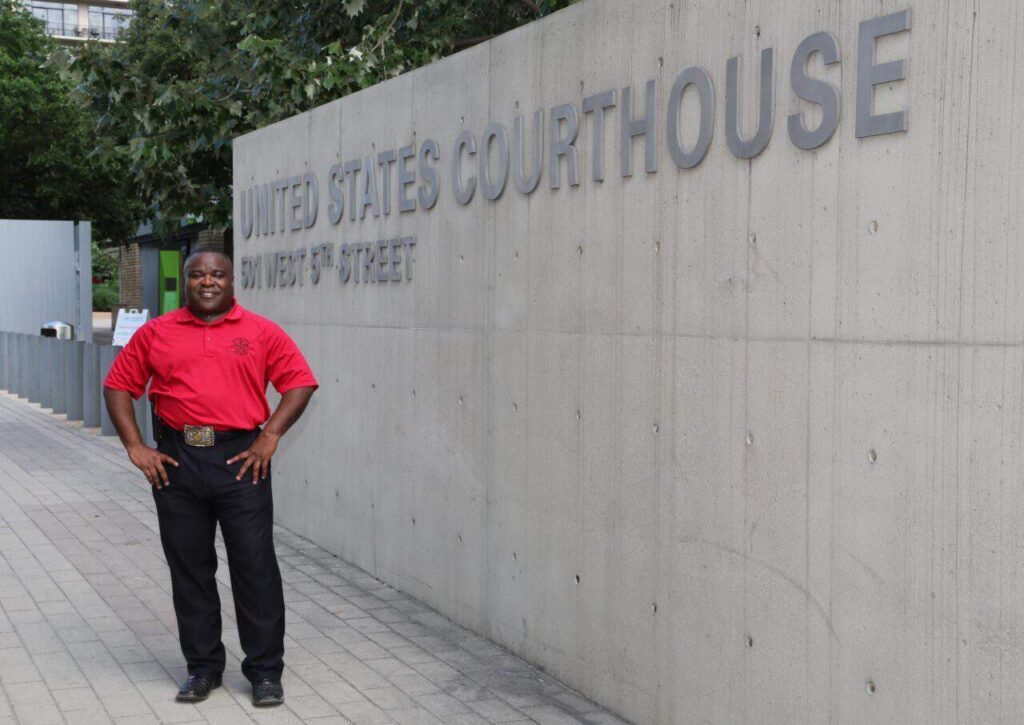The Supreme Court grappled on Wednesday over the legality of a federal ban imposed under former President Donald Trump on bump stocks, which make semiautomatic rifles fire rapidly, with several justices questioning whether Congress is needed to enact such restrictions.
The high court’s oral arguments centered on an appeal by President Joe Biden‘s administration of a lower court’s ruling in favor of Michael Cargill, a gun shop owner and gun rights activist based in Austin, Texas, who challenged the ban that was put in place during the Trump administration after the 2017 Las Vegas mass shooting that resulted in 60 deaths. The Las Vegas shooter had used a bump stock during the massacre.

At the core of the case is whether the Bureau of Alcohol, Tobacco, Firearms, and Explosives, an agency within the Justice Department, properly interpreted a law banning machine guns when it extended the law to include bump stocks. The rule went into effect in 2019, forcing bump stock owners to surrender their devices or else face stiff fees and a felony carrying up to 10 years in prison.
Several members of the high court’s 6-3 Republican-appointed majority appeared skeptical of the ban, with some expressing a degree of sympathy for the ATF’s logic behind enacting such restrictions while signaling their concerns with the lack of congressional involvement in enacting the ban.
“Intuitively, I am entirely sympathetic to your argument. I mean, it seems like, yes, this is functioning like a machine gun would,” said Justice Amy Coney Barrett, a Trump appointee. However, Barrett questioned why Congress didn’t pass legislation “to make this covered more clearly.”
Justice Brett Kavanaugh, another Trump appointee, said he was concerned about some U.S. residents facing prosecution under a ban they may not be aware of.
“Even if you’re not aware of the legal prohibition, you can be convicted,” Kavanaugh told an attorney representing the Biden administration. “That’s going to ensnare a lot of people who were not aware of the legal prohibition.”
More than 500,000 U.S. residents who previously purchased a bump stock have been forced to turn theirs in, and gun advocates such as Cargill have said the loss of property value likely exceeds $100 million.
Another Trump appointee, Justice Neil Gorsuch, focused more directly on why the ATF should have the authority, rather than Congress, to enact a bump stock ban.
“I can certainly understand why these items should be made illegal, but we’re dealing with a statute that was enacted in the 1930s,” Gorsuch said. “And through many administrations, the government took the position that these bump stocks are not machine guns.”
Gorsuch and Kavanaugh also cited several lawmakers who have suggested an administration couldn’t ban the devices on its own, including references to the late Sen. Dianne Feinstein (D-CA), a staunch gun control advocate who was vocal about a need for legislation to enact such bans.
“I believe there are a number of members of Congress … who said that this administrative action forestalled legislation that would have dealt with this topic directly,” Gorsuch said.
The high court’s three Democratic-appointed justices — Sonia Sotomayor, Elena Kagan, and Ketanji Brown Jackson — based their questions on the notion that rifles equipped with bump stocks effectively work like machine guns.
“The entire point of this device,” Kagan said, is the shooter pushes forward on the weapon while shooting and that “a torrent of bullets shoot out.”
DOJ lawyer Brian Fletcher was asked at one point by the high court to explain how the bump stock’s features satisfy the definition of a machine gun.
“Take an M16, you pull the trigger back, and you hold it, and it keeps shooting. With a bump stock, you push forward, and that both initiates and continues the firing,” Fletcher said.
After the devastating Las Vegas shooting, in which the shooter equipped a rifle to fire down on pedestrians from the 32nd floor of a hotel, then-President Trump urged the ATF to move expeditiously on forming its rule that was published in 2018, partially due to mounting political pressure.
“We’re knocking out bump stocks,” Trump, who touts himself as an ardent gun rights defender and is seeking to become the GOP presidential nominee, said during a White House news conference in 2018.
The shooter, 64-year-old Stephen Paddock, fired more than 1,000 rounds of ammunition in roughly 11 minutes. Fletcher argued the bump stocks subject to the ATF ban allow semiautomatic rifles to fire between “400 and 800 rounds per minute,” arguing that falls in the same range as machine guns issued to members of the military, which fire between 700 and 950 rounds per minute.

Cargill surrendered his bump stocks after the rule was published and immediately challenged the ATF rule in Texas federal court, arguing Congress should first pass a statute with a broader definition of machine guns or banned devices that make a semiautomatic gun fire at rates similar to machine guns.
“The Trump administration came out and said they were going to ban the bump stocks by way of going through the ATF instead of going through Congress, and so that disturbed me,” Cargill told the Washington Examiner, accusing the agency of taking power away from Congress.
The U.S. Court of Appeals for the 5th Circuit ruled 13-3 in favor of Cargill last year, finding that, at a minimum, “single function of the trigger” and “automatic” are ambiguous terms used in the rule. Due to that ambiguity, the court’s majority said the “rule of lenity,” which requires a court to apply the law in a manner most favorable to the defendant, applied to Cargill.
If not for the hangup among some of the justices on the lack of clear legislation behind banning bump stocks, the majority of the court appeared inclined to uphold the ban. However, several of the justices seemed skeptical of allowing such a rule to stand without a clear intention by Congress, which has previously failed to reach a deal banning the accessories, most recently with a bipartisan bill introduced last year that never made it past its referral to the Senate Judiciary Committee. A decision in the case is expected by June.
Even if the high court overturns the ATF ban, bump stocks will still not be available nationwide, as 18 states already have laws banning the devices.
The high court has historically given favor to gun rights cases addressing the scope of the Second Amendment, though legal experts say this is a case of statutory interpretation.
CLICK HERE TO READ MORE FROM THE WASHINGTON EXAMINER
In 2022, the Supreme Court ruled 6-3 that New York’s concealed carry permit regime was unconstitutional and established a new legal test to evaluate whether gun laws conform to the historical and traditional standards of the Second Amendment.
The justices indicated in November arguments in a separate case that they may stop short of striking down a long-standing federal statute involving a gun ban for people accused of domestic violence.

